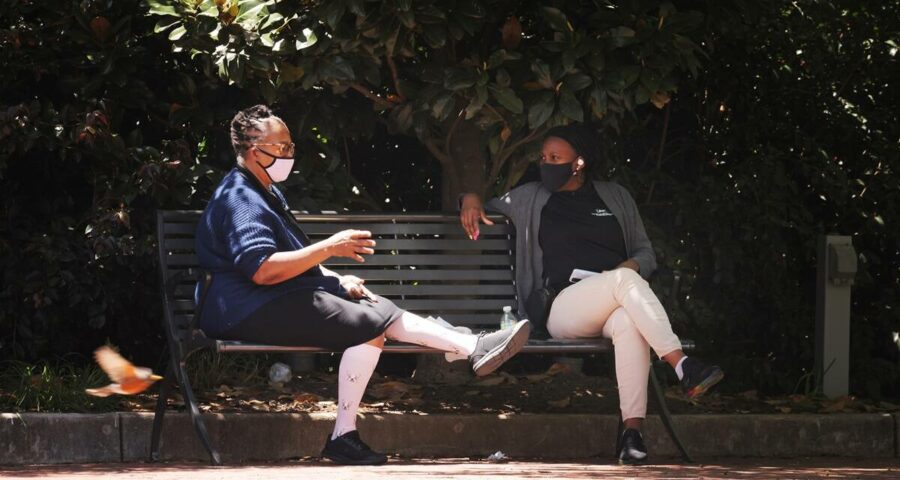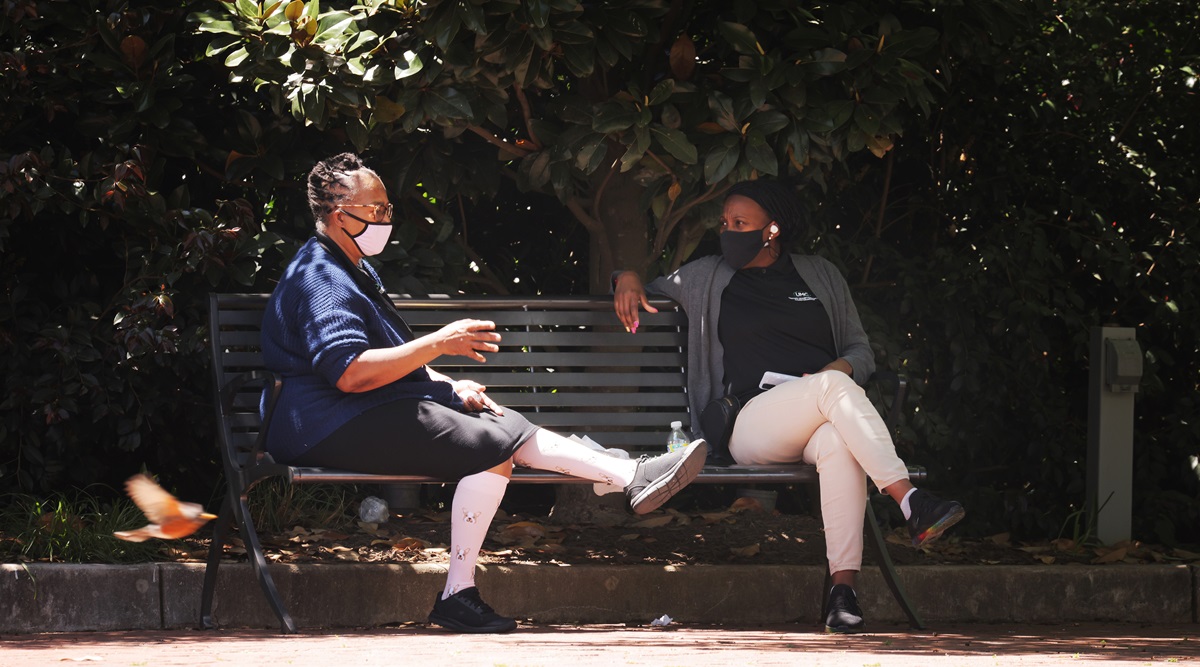The mask guidance is modest and carefully written: Americans who are fully vaccinated against the coronavirus no longer need to wear a mask outdoors while walking, running, hiking or biking alone, or when in small gatherings, including with members of their own households.
Written by Sheryl Gay Stolberg and Roni Caryn Rabin
The Centers for Disease Control and Prevention took a major step Tuesday toward coaxing Americans into a post-pandemic world, relaxing the rules on mask wearing outdoors as coronavirus cases recede and people increasingly chafe against restrictions.
The mask guidance is modest and carefully written: Americans who are fully vaccinated against the coronavirus no longer need to wear a mask outdoors while walking, running, hiking or biking alone, or when in small gatherings, including with members of their own households. Masks are still necessary in crowded outdoor venues like sports stadiums, the CDC said.
But President Joe Biden hailed it as a landmark moment in the pandemic, wearing a mask as he approached the lectern on a warm spring day on the White House grounds — and pointedly keeping it off as he walked back into the White House when he was done.
“Go get the shot. It’s never been easier,” Biden said. “And once you’re fully vaccinated, you can go without a mask when you’re outside and away from big crowds.”
The CDC stopped short of telling even fully vaccinated people that they could shed their masks outdoors altogether — citing the worrying risk that remains for transmitting the coronavirus, unknown vaccination levels among people in crowds and the still-high caseloads in some regions of the country. The guidance also cautioned even vaccinated people against going without masks in medium-size outdoor gatherings.
But even the CDC’s director, Dr. Rochelle Walensky, emphasized a more expansive interpretation, telling reporters at a White House briefing, “We no longer feel that the vaccinated people require masks outdoors,” outside “large public venues, such as concerts, stadiums and things like that.”
The order had immediate ripple effects in the states. Governors in California, New York, Louisiana, Maine and Massachusetts all relaxed outdoor mask mandates after the CDC’s announcement. In Tennessee, Gov. Bill Lee, a Republican, went much further, ignoring the federal government’s advice as he declared it was “time for celebrations and weddings and conventions and concerts and parades and proms” to take place “without limits on gathering sizes.”
On Capitol Hill, a group of Republican lawmakers who are also medical professionals released an advertisement Tuesday encouraging vaccination, in which they appeared wearing white coats with stethoscopes draped around their necks. Sen. Roger Marshall, a freshman Republican from Kansas and a medical doctor, told viewers that the reason to get vaccinated was simple: “So we can throw away our masks, and live life as free as before.”
Marshall, who organized the effort, said it was based on research conducted by Frank Luntz, a Republican pollster working to reduce vaccine hesitancy among conservatives. In an interview, Luntz said Biden’s announcement was a positive step, and could give people who are reluctant to get vaccinated a reason to get their shots.
“It gives them a light at the end of the tunnel,” he said. “‘Tell me when I can get rid of my mask’ is actually the language that they use, so the fact that this is a meaningful, measurable step toward returning to normal is a big deal.”
For Biden, who will address Congress on Wednesday and mark his 100th day in office Thursday, the CDC’s announcement was a moment to bask in what he called the “stunning progress” Americans had made since he took office. Next week, he said, he will outline a plan “to get us to July 4 as our target date to get life in America closer to normal and begin to celebrate our independence from the virus.”
The guidelines issued Tuesday reflect some basic coronavirus math: As the number of vaccinated people goes up, cases are going down.
So far, about 43% of Americans have received at least one dose of a COVID-19 vaccine, and 29% have received both doses of the two vaccines requiring double shots. The United States is averaging around 55,000 new cases a day, a roughly 20% drop from two weeks ago, according to a New York Times database.
“I know the quarantine and shutdowns throughout the pandemic have been exhausting,” Walensky said. “I know we all miss the things we used to do before the pandemic, and I know we all want to do the things we love and soon. Today is another day we can take a step back to the normalcy of before.”
Her remarks, and those of the president, got a welcome reception even from some of the Biden administration’s fiercest Republican critics in Congress, many of whom have complained that coronavirus restrictions were an intrusion on their personal freedoms.
Sen. Ted Cruz, R-Texas, who quit wearing masks indoors after he was vaccinated, said he was “glad the CDC finally acknowledged what has been obvious for a long time, which is that wearing a mask outside is silly and not remotely justified by the science.”
In fact, the science behind the CDC’s new guidance is not comprehensive. A growing body of research indicates that the odds of the virus spreading outdoors is far lower than it is indoors, but the risk is not zero and is hard to quantify.
Most if not all of the research about viral transmission outside was done before the vaccine was available, so it does not distinguish between the risk to those who are inoculated and those who are not.
But experts say that viral particles disperse quickly outdoors, meaning brief encounters with a passing walker or jogger pose very little risk of transmission.
“The two main things you have going for you outdoors is that the virus rapidly becomes diluted” and decays quickly in the sunlight, said Linsey Marr, an aerosol expert at Virginia Tech, adding, “I think something like sitting at a baseball game where people are really cheek by jowl, side by side, and in front and behind each other, and there’s yelling, cheering — I would wear a mask in that situation.”
One of the paper’s authors, Dr. Nooshin Razani, an associate adjunct professor in epidemiology, biostatistics and pediatrics at University of California, San Francisco, cautioned that the low odds of transmission outdoors may simply reflect the fact that people spend little time outdoors.
In one documented case in Italy, the virus spread between joggers who were running outdoors together, side by side.
The CDC’s new guidance was issued amid growing debate over why the federal government was still recommending that people wear masks outdoors. Writing in The New England Journal of Medicine last week, Dr. Paul Sax, an infectious disease expert at Brigham and Women’s Hospital in Massachusetts, said it was time to end outdoor mask mandates.
Along with the guidelines, the CDC published a color-coded chart outlining masking recommendations for a variety of scenarios such as, “dine at an outdoor restaurant with friends from multiple households,” “visit a barber or hair salon” and “go to an uncrowded, indoor shopping center or museum.”
But Marr said that seemed overly complex: “I would have to carry around a sheet of paper — a cheat sheet with all these different stipulations.” She added: “I worry that this is not as helpful as it could be.”
Source: Read Full Article


